America in 2072: A Society Stratified by Genetic Enhancement
My submission to the effective ideas essay contest: "The world in 2072: We want to read about visions of the world 50 years from now."
This post is part of an essay contest for effectiveideas.org. The prompt is: “The world in 2072: We want to read about visions of the world 50 years from now. Fiction or forecasts are welcome.”
I. A History of Genetic Enhancement
On 25 July 1978, Louise Brown was born at Oldham General Hospital in Greater Manchester, UK. In what is regarded as one of the most important breakthroughs for medicine of the 20th century, doctor Patrick Steptoe, physiologist Robert Edwards, and embryologist Jean Purdy conceived a human being in a petri dish who was later successfully delivered into the world.

This process, called in vitro fertilization, is the process of collecting egg(s) from a woman and fertilization them with sperm in a laboratory. Select embryo(s) can then be implanted in either the same woman or a surrogate. Later advancements in human biology provided the ability to test embryos for health prior to implementation (Parikh et al., 2018). In 2001, a 38-year-old woman with a 7-year history of infertility successfully conceived a child after her embryos were screened with a method known as fluorescence in situ hybridization (FISH), increasing the chance of successful pregnancy by selecting a karyotypically normal embryo (Wilton et al, 2001). The baby was born with normal weight, length, and head circumference after 38 weeks.
At present, screening embryos is now common practice for parents using IVF. If the woman is experiencing frequent miscarriages or is over the age of 35, she may undergo preimplantation genetic testing for aneuploidies (PGT-A), structural chromosomal rearrangement (PGT-SR), and monogenic diseases (PGT-M). Not all diseases are monogenic, some are polygenic—a consequence of multiple genes. Recent advances in genetics have made the prospect of preimplantation genetic testing for polygenic disorders (PGT-P) a reality. In the summer of 2020, Aurea Smigrodzki became the first human to be born after undergoing this procedure (Genomic 2021, Q2).
The cost of gene sequencing has fallen drastically since the completion of the Human Genome Project in 2003, facilitating the creation of the datasets necessary for analyzing the relationships between genes and expressed traits. As more people have their genome sequenced and more genome-wide association studies (GWAS) are performed, we will better understand the causal role that genes play in developing certain diseases and traits.

Polygenic risk scores for various diseases can be aggregated into something called the Embryo Health Score (EHS), which is “the sum of the predicted absolute risks for each disease condition weighted by the life-span impact of the condition” (Tellier et al., 2021). Parents can select the embryo that is expected to live the longest using this criterion.
In addition to being a healthy person, parents want their child to have traits like kindness, ambition, mental stability, and intelligence. We know that selection for all personality traits is possible because of what is sometimes called the first law of behavioral genetics: all behavioral traits are heritable (Plomin et al., 2016). Despite some traits being good, the genotypic maximization of certain traits may be undesirable. This is one of many ethical concerns and potential consequences of granting people the ability to shape their future children (Anomaly, 2020).
For example, imagine parents wanted to create a child that was the maximum in his or her polygenic score for kindness. Perhaps it could manifest in being excessively trusting or pathologically altruistic. People with a condition called Williams Syndrome are sometimes considered too nice for their own good:
Imagine walking down the street and suddenly running into a dangerous person. You would most likely be startled, cross to the other side of the street, and possibly even call the police. Well, a person with Williams syndrome would probably be so excited to see a stranger’s face that he or she might not notice that the stranger is dangerous. People with Williams syndrome are described as having exceptionally friendly personalities, extremely sensitive and empathic, and therefore are also called “love children.”
This level of friendliness could be problematic and dangerous. People need to have a healthy level of skepticism toward strangers because the world is threatening at times. Another example of the dangers of excess is ambition; a maximally ambitious person may be ruthlessly competitive and unable to care much about family and friends. We should be precautious in what we are selecting for when we begin selecting embryos for behavioral traits. Extremes of behavioral traits are typically maladaptive.
Could intelligence be the exception? It is very advantageous to be highly intelligent in a modern economy. It affords the ability to get more education and higher wages, in addition to many other positive life outcomes. People who are exceptionally brilliant might not suffer from disadvantages like an extraordinarily kind or ambitious person would.
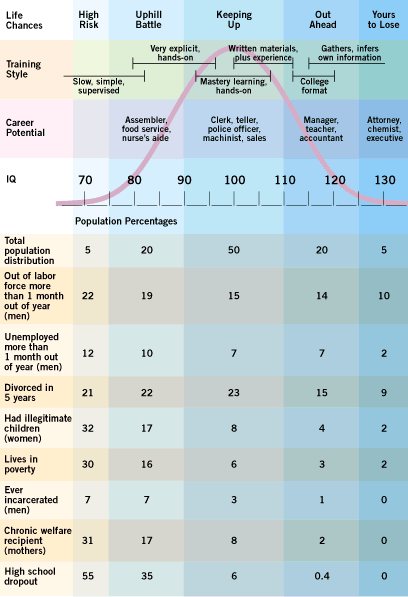
Most people are at moderate risk for negative life outcomes. On the right side of the bell curve, a small percentage of the population is not likely to have negative life outcomes. On the left, the chances are much higher. Moving from having the ~70 IQ category to the ~130 IQ results in a massive decrease in the probability of having negative life outcomes. Avoiding poverty, incarceration, welfare dependency, divorce and unemployment are extremely desirable, and I suspect that parents with an understanding of this fact would also be interested in polygenic risk scores for intelligence.
The heritability of adult intelligence in the developed world is perhaps as high as 80% (Plomin and Deary, 2014). This means that in the developed world there are more phenotypic gains to be had by bringing the average person to the genotypic norm than the environmental norm. If embryos are screened for intelligence, it is conceivable that there could be large gains to be had.
However, it’s important to note that heritability is a population and time relative statistic. It is often described as the “proportion of phenotypic variation that is due to genetic differences” (Sesardić, 2005, p. 11). If the environment changes or genetic differences increase, we would expect to see a change in heritability. A perfectly equalized environment would result in 100% heritability. If everyone underwent genetic engineering to achieve the genotypic maximum for a given trait, heritability would fall to 0% because environmental variation would explain all the differences. While higher heritability suggests less malleability in some sense, it does not indicate an absolute limit to returns from environmental and genetic changes (Sesardić, 2005, pp. 153-182).
Intelligence is a trait with hundreds of contributing genes, resulting in a normal distribution across the population. Psychometricians typically measure this trait with intelligence tests normed such that the average is 100 and the standard deviation is 15 points. It is unlikely that even the smartest person alive had literally all the variants for intelligence and absolutely no deleterious mutations. This fact in combination with better environmental conditions gives us reason to suspect that human beings could be born that are much smarter than anyone who has ever lived.
However, it is incredibly unlikely that you could find that person in a batch of six or so embryos from an average person. Getting many batches from the same woman is currently not very desirable or feasible. Extracting ova is uncomfortable but there are gains to be had from selecting from a larger pool of embryos. The next generation will experience regression toward the mean but will still retain some of the gains. If future generations continue to do embryo selection, the average human cognitive ability for the descendants of the enhanced population will continue to rise.
Across many generations, large increases in cognitive ability could be realized with embryo selection. It is feasible that those gains could be realized much more rapidly through a process called “iterated embryo selection” (IES). In their paper “Embryo Selection for Cognitive Enhancement: Curiosity or Game-changer?”, Carl Shulman and Nick Bostrom explain the process (Shulman and Bostrom, 2013):
1. Genotype and select a number of embryos that are higher in desired genetic characteristics;
2. Extract stem cells from those embryos and convert them to sperm and ova, maturing within 6 months or less (Sparrow, 2013);
3. Cross the new sperm and ova to produce embryos;
4. Repeat until large genetic changes have been accumulated.
The potential returns are so large that it would be difficult to predict just how intelligent the resulting person would become, and it’s not clear what the limits to this process are. There could also be downsides to certain IQ-increasing alleles. Even if this process merely achieved people only a bit smarter than Albert Einstein or John von Neumann, this would profoundly change society for the better and accelerate scientific progress tremendously.
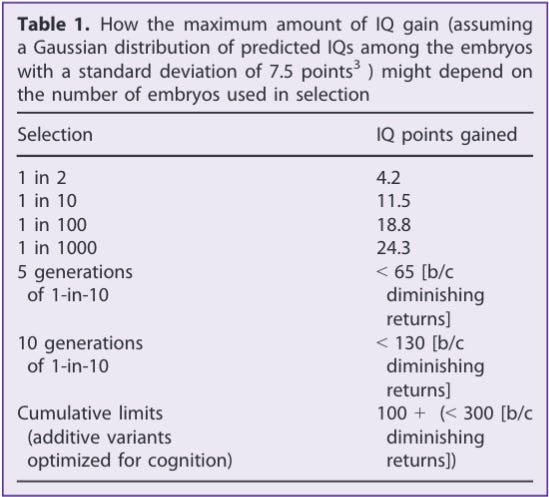
Rather than selecting from embryos, it may be possible to edit genomes directly for desired traits using CRISPR-Cas9. CRISPR—clustered regularly interspaced short palindromic repeats—is a family of DNA sequences used by the cas9 enzyme as a guide for editing. This allows for a more exact selection than choosing embryos. With CRISPR, a specific undesirable gene variant can be targeted and replaced with a more desirable gene variant.
In November of 2018, He Jiankui—a former genome-editing researcher at the Southern University of Science and Technology of China in Shenzhen—claimed to have edited and implanted two embryos. Using CRISPR-Cas9, He disabled the gene CCR5 in an effort to reduce the probability of HIV infection. This was a shocking announcement and raised a number of bioethical concerns. In 2019, He was sentenced to three years in prison and fined the Chinese equivalent of $430,000. He was released earlier this year (2022).
II. The Near Future of Genetic Enhancement
The cost of sequencing a single genome is no longer a major impediment to genetic enhancement. Selecting from a collection of 6-10 embryos would not be prohibitively expensive for a middle-class American family. However, sequencing many embryos could quickly become very expensive. The more embryos, the better the results of the selection. The polymath and researcher Gwern Branwen has a very informative article in which he compares various methods and their associated costs (Branwen, 2020).
A major technical impediment currently is the conversion of pluripotent stem cells (PSCs) to gametes. This conversion would permit the selection of embryos from an extremely large number of ova, allowing for iterated embryo selection (IES) and massive multiple embryo selection (MMES). According to the Metacalculus community, the birth of the first stem-cell-derived person is likely to occur within the next 20 years. The lower 25% estimate is 2030 and the upper 25% estimate is 2042. The median is 2036.
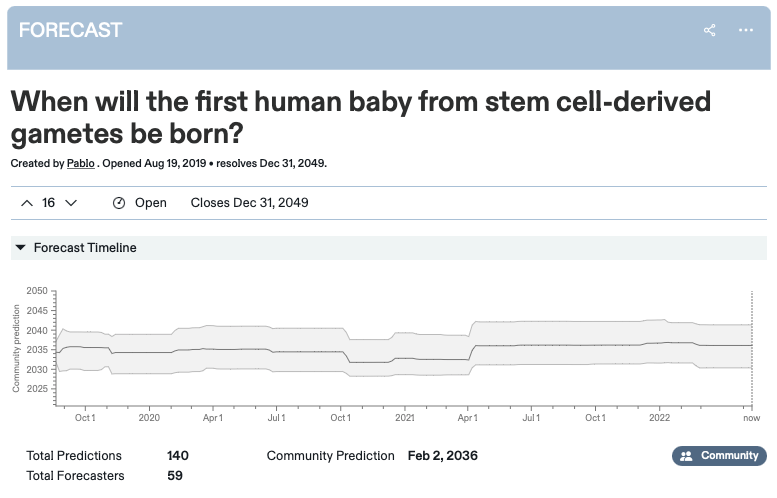
Following the first baby being born from stem cell-derived games, we would expect to see a selection from larger cohorts of embryos to improve health. According to Metaculus, the median estimate for the first massive multiple embryo selection above 50 embryos is 2035. The lower 25% is 2029, and the upper 25% is 2049.

With a decently high probability, we should expect that a human baby has been born from stem cell-derived gametes by 2072. In fact, we would expect that many people would have been born, especially considering that it opens the way for gay and lesbian couples to have biologically related children. Since the genetic enhancement processes confer a major advantage in terms of health and intelligence, we should expect millions of people to be born through one of these processes.
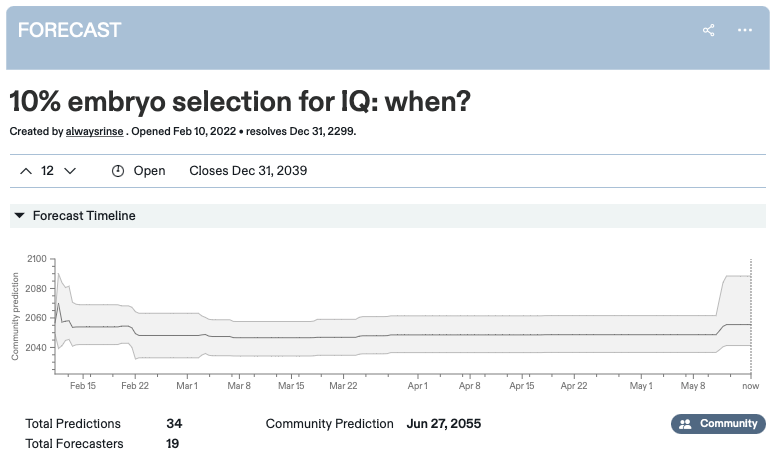
The most unpredictable element in the advancement of genetic enhancement may be the legal concerns. Will Republicans reject this process on account of it behaving like God and discarding embryos—who many regards as a human with the right to life? From this perspective, iterated embryo selection and massive multiple embryo selection could be regarded as a massacre, amplifying the number of abortion murders by perhaps as much as an order of magnitude. Will Democrats reject the process on account of unfairness? Or will they defend it as an instance of a woman’s right to choose? There is a real chance of bipartisan rejection of this sort of technology.
The health and welfare of millions of people potentially rely on these questions. Parents may be willing to leave their home country—especially if enhancement reaches the point that their future child could live decades longer, escape the risk of depression, avoid all congenital diseases, and be smarter than 99.99% of the population. The returns will likely be larger than any environmental intervention could afford, even for fabulously wealthy parents. The returns from sending one’s child to a private school, hiring tutors, purchasing expensive medication, or using the best doctors available—something parents spend tens of thousands of dollars on— will almost certainly pale in comparison to the gains from genetic enhancement.
III. Predictions About the Year 2072 in America
There are a number of possible futures that hinge on certain aspects of the above predictions. If the practice is totally prohibited or technology advances much slower than anticipated, my predictions won’t come to fruition. This is a prediction with low confidence and should be interpreted as one possible scenario. Predicting the future 50 years in advance is extraordinarily difficult. For example, if you didn’t predict the invention of the internet in 1972, then you missed quite a bit about 2022.
I think that there will be three classes of people, the enhanced, the semi-enhanced, and the unenhanced. Enhanced people will have undergone iterated embryo selection or gene editing for maximal benefit, while semi-enhanced will have only undergone less effective forms of enhancement to prevent disorders. Since the term enhanced conveys something positive, there will be concerns about politically correct language use. Since there are so few genetically enhanced people at present, this isn’t as much of a concern.
The enhanced population will be noticeably more physically fit, intelligent, attractive, and happy. Many may have a very exotic appearance depending on the level of social stigma associated with being enhanced. While many parents will elect for their child to blend in with others, some will elect for their child to stand out with traits such as bright red hair, green eyes, freckles, blond afros, unusual facial features, seven-foot-tall, etc. Most will likely pick beautiful children that look like their parents. Since some elements of attractiveness are relative to some degree—like height—there are concerns about competition driving selection too far. There will be many social issues around selection for physical appearance, and other issues that involve strategic and ethical decision-making about the traits of offspring (Anomaly, 2020).
There will also be different sides to major debates around creating future people. One stance is procreative beneficence, the idea that “couples (or single reproducers) should select the child, of the possible children they could have, who is expected to have the best life, or at least as good a life as the others, based on the relevant, available information” (Savulescu, 2001). This will contrast with the position of procreative altruism, “according to which parents have significant moral reason to select a child whose existence can be expected to contribute more to (or detract less from) the well-being of others than any alternative child they could have” (Douglas et al., 2013). However, these debates will be isolated to the communities that view enhancement as acceptable and are able to attain it.
The major issue will be the divide between the enhanced and the unenhanced. The issue of enhancement is going to overshadow other inequality concerns. Semi-enhanced people will largely blend in with the unenhanced population. They will not have majorly negative congenital disorders, but they will not appear noteworthy in any way other than being somewhat healthy. People will not care so much about the semi-enhanced because they don’t have as high a degree of concern around preventing horrible diseases as they do about giving what are interpreted as advantages (Funk and Hefferon, 2018).
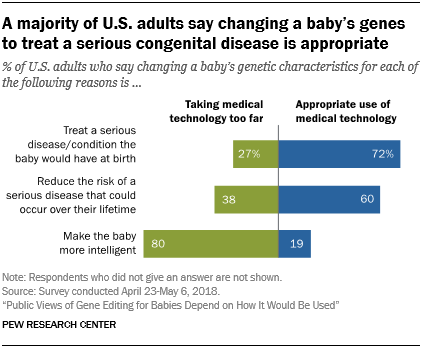
The enhanced and unenhanced may be profoundly different. In addition to being significantly healthier and happier, it’s feasible that by 2072, the enhanced population is smarter than any human who ever lived. Since we do not see diminishing returns for gains in intelligence, it’s reasonable to expect that associations between cognitive ability and socioeconomic factors may continue even at high levels. As discussed above, high cognitive ability, as measured by IQ, is associated with many very desirable traits (Branwen, 2017). Intelligent people have better academic performance (r=0.58) (Poropat, 2009), higher educational attainment (r=0.56) (Strenze, 2007), better job performance (Hunter and Hunter, 1984), better occupational attainment (r=0.43) (Strenze, 2007), higher income (0.20) (Strenze, 2007), higher graduate school research productivity (r=0.19) (Kuncel et al. 2004), more creativity (0.17) (Kim, 2005), and more happiness (r=0.05) (DeNeve and Cooper, 1998).
Depending on the degree to which artificial intelligence has replaced the need for higher intelligent workers and rent-seeking behavior has prevented the protection of workers from AI taking their jobs, it could be the case that the enhanced population is significantly more productive in their work productivity, research productivity, and creativity. If quotas are not implemented, the enhanced population will come to dominate all disciplines which rely on intelligence: programming, law, finance, statistics, academia, etc. While a decent amount of the increase in productivity will be captured by the enhanced population, this will increase everyone’s wealth substantially but concerns about inequality will be common. The enhanced population will likely be significantly more wealthy and successful, creating resentment among the unenhanced.
The enhanced population will likely assortatively mate. It’s already the case that “[a]ssortative mating is greater for intelligence (spouse correlations ~0.40) than for other behavioural traits such as personality and psychopathology (~0.10) or physical traits such as height and weight (~0.20)” (Plomin and Deary, 2014). If the enhanced population achieves extremely spectacular returns (100+ IQ points), then they will be largely uninterested in normal members of the population for long-term mating.
Friendships will likely be particularly uninteresting for the enhanced, but more common than mixed relationships that aren’t strictly sexual. The most common form of mixed relationship will be between parent and child, or grandparent and grandchild. Otherwise, the enhanced population will likely spend little free time with the unenhanced population, just as someone with an IQ of 150 spends little free time with people with IQs of 50. With a sizeable enough population, the enhanced may self-segregate to a large extent.
The personality traits of the extremely enhanced will be hard to understand and will depend to some extent on the traits selected by the parents. They will likely be irreligious because cognitive ability and religiosity are negatively associated (r=-.20 to -.23) (Zucherman et al., 2019). They will likely have fewer children because cognitive ability and fertility are negatively associated (Lynn, 1996). If the enhanced feel it is necessary to have an enhanced child, they may be dissuaded from having many if the cost is exorbitantly high. Rather than choosing the intermediate of having the child, but not enhancing it, they may elect to not have the child at all. This behavior is mirrored in many upper-middle-class parents who feel the need to invest heavily in their children’s future, likely reducing their fertility rate (Caplan, 2012).
While those who elect for enhancement will have low fertility, those with strong ideological objections to enhancement will likely have high fertility. A 2018 poll found that 93% of highly religious people viewed using medical technology for making a baby more intelligent as “going too far” (Funk and Hefferon, 2018). Christians have higher fertility than atheists, perhaps in part because of calls for reproduction within the Bible; “And God said to them, ‘Be fruitful and multiply and fill the earth and subdue it, and have dominion over the fish of the sea and over the birds of the heavens and over every living thing that moves on the earth’” (Genesis 1:28). Or perhaps there is a genetic relationship between religiosity and fertility.

While the process will only be starting in 2072, it may be the case that there is a rise and fall of enhancement from the 2040s to the 2090s, and then demographic trends will cause a proliferation of people who will oppose it. The enhanced population may never reach a majority and many may feel actively hostile toward them. Rather than rampant discrimination against those who are born naturally, as the science fiction film GATTACA envisions, we may see rampant anti-enhanced attitudes and legal discrimination. If parents leave the country to enhance their children, they may not be welcomed back or their actions may be harshly stigmatized. The enhanced population would likely be much more tolerant of the unenhanced because the enhanced population will likely have been selected for prosocial traits.
Perhaps the enhanced population will be welcomed by a different country, or maybe the integration of enhanced and unenhanced is untenable, leading to the formation of separate nations. Many unenhanced will likely sympathize and want to live among the enhanced, who will likely have a better functioning government and higher levels of social trust. Whatever the state of affairs in 2072, there will be major controversies surrounding genetic enhancement, as well as a great deal of social conflict created from the resulting disparities.
It is an ethical imperative to ensure that parents can at least have offspring that are healthy and happy. Genetic enhancement has not yet garnered public attention and is in a precarious situation. If PGT-P is banned, many people may live substantially more depressing and unhealthy lives. Effective altruists should support medical technology for genetic enhancement and develop strategies and rhetoric to prevent possible bans. Future altruists will likely need to find effective arguments to prevent hostility between populations.



Editing genomes for highly polygenic traits such as IQ is unlikely to be feasible with CRISPR because of off-site damage rates. A 10% rate (i.e. 90% probability of no adverse impact on the zygote) per edit is acceptable for editing low single digit number of sites, but as the number of edits grows, overall success rate drops exponentially. If you try to edit 10 sites, your success rate will be 0.9^10≈1/3. For 20 sites it's 1/8, for 30 sites it's 1/24, for 50 sites - 1/194, and for 100 sites - 1/37,600. If Steve Hsu’s estimates (http://arxiv.org/abs/1408.34210) of the genetic architecture of intelligence are correct and the number of sites that determine g is on the order of 10,000, with about 1,000 sites per standard deviation, editing for g is impracticable unless off-site damage rate per edit is brought down to about 0.25%. This estimate is crude and does not account for possible interactions between edits or for damage to the zygote from the sheer amount of enzymes and guide RNA dumped into it.
As for the kind of welcome that might be extended to hypothetical enhanced populations, a useful comparison is market-dominant minorities.
Good writeup. Of course most of it requires little/no prohibition at least somewhere in the world (which does seem pretty likely).
But I think you're missing what seems to me to be the most interesting consequences:
1 - As people get smarter, the way they think may change.
My personal observation has been that people with highish IQs (~115 to 135) are more leftist than most. It's not clear to me if the same is true of people with extremely high IQs (> 140).
Given that leftist societies tend to collapse, I wonder about the social consequences of rising median population IQs.
(I may be just conflating education effects with intelligence effects, in which case nevermind.)
2 - More important, this is a first step down a path of recursive genetic modification. We've some idea of how we'd change our children, if we could. We have less idea of how those children - different from us - will choose to change their own children - etc. down the generations. The path seems unpredictable, potentially chaotic, and may lead to extinction.
I don't think we have any good reason to think that after 5 or 10 generations of such changes, the result will look anything at all like present humans.
(This is similar to the "AI explosion" recursive improvement argument.)